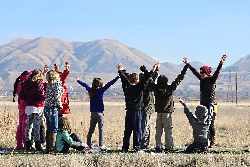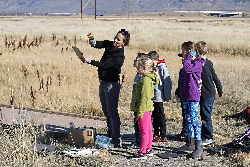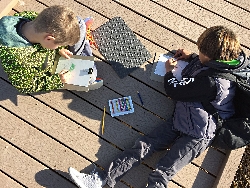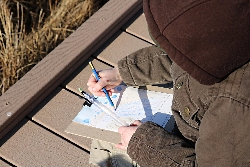
Bear River Migratory Bird Refuge
Courtesy & Copyright Edith Bowen Laboratory School(EBLS)
Experiential Learning
Eric Newel Director & Photographer
- *Field Recording:
Isa Identifies Raptors
So eagles fly how?
Student:
Straight.
Isa:
How do buteos fly? Like a red tail? They are modified dihedral.
How do vultures fly? They are wobbly and in a V
How do Accipitors fly? Flap-flap-glide

Bear River Migratory Bird Refuge
Courtesy & Copyright Edith Bowen Laboratory School(EBLS)
Experiential Learning
Eric Newel Director & Photographer
- Edith Bowen third graders recently had the opportunity to visit the Bear River Migratory Bird Refuge in Brigham City. The day was chock a block full of exciting activities like the one we just heard meant to engage students’ senses and ground their understanding of core curriculum within the context of the place we were visiting.
![[We] learn better when we’re immersed in the context of the thing we study. Courtesy & Copyright Edith Bowen Laboratory School(EBLS) Experiential Learning Eric Newel Director & Photographer [We] learn better when we’re immersed in the context of the thing we study. Courtesy & Copyright Edith Bowen Laboratory School(EBLS) Experiential Learning Eric Newel Director & Photographer](https://wildaboututah.org/wp-content/uploads/newell.eric_.24210275_1682307758487950_3483302022023119046_o.250x167.jpg)
Courtesy & Copyright Edith Bowen Laboratory School(EBLS)
Experiential Learning
Eric Newel Director & Photographer
- Place-based and experiential education are relatively new terms for old human evolutionary qualities. Basically, we humans learn better when we’re immersed in the context of the thing we study. Being in a place, engaging each of our senses in its character, and learning how that character and our own are interdependent builds powerful context. When educators can insert their core curriculum into that context each strand of understanding becomes deeper and richer.
So we had people like my friend Isa, who you heard at the beginning of the segment, racing with students through the grasslands, imitating the flight patterns of raptors to drive home an understanding of adaptive specificity in different bird species.

Courtesy & Copyright Edith Bowen Laboratory School(EBLS)
Experiential Learning
Eric Newel Director & Photographer
Our art teacher, Lisa Saunderson, sat with students to observe and ponder the landscape before teaching them to expertly render their horizons in watercolors. For my small part, I sat with students- six or seven at a time- and introduced them to Aldo Leopold. As it was the final day of November, I read from the Chapter of A Sand County Almanac honoring the month.
In reading Leopold’s words, I wanted to model for my students how close, careful observation can deepen our experience of a place and even transcend time through the words we write down- fleeting thoughts becoming immediately eternal with the stroke of a pen. When I gave them time of their own to sit, observe, and write, what they came up with gave me goosebumps.
- Field Recording: Avery’s reading
- All Around Me by Avery F.
- In front, water is weaving around a maze of marsh
Beside me there is a bench standing all alone.
Behind there is a wall of stalks, some almost as tall as me.
Beside there is an endless walk waiting for men to walk and talk.
- Field Recording: Lila’s reading
- November ends
The deep coolness flows through the cheeks and the nose
The water is as still as rock
Cattails are stuck in black tar
The birds whistle and sing
It spreads and spreads until you can’t hear
The grass flows as the wind blows
Where am I?

Courtesy & Copyright Edith Bowen Laboratory School(EBLS) Experiential Learning
Eric Newel Director & Photographer
Awareness of a place produces powerful perspectives of it, especially among the tiny human sponges we call children. The day went on and on like this, students building deep contextual understandings of their place. What were once the far hinterlands of their home range became an intimate, familiar setting they knew and spoke of fondly. Eyes lifted to goose music and the whistle of flight feathers thereafter.
To finish our visit, we heard a welcome interpretation of the natural history of the bird refuge- a bit of geographical orienting for the kids to digest and incorporate into their understanding of the place.
- Field Recording: Ranger Interpretor
- You live in what is called, (And this is a 4th-grade concept, but your guys are so smart, you know it just like that.)
The Bear River Watershed.
Okay, it is the corridor, in this valley, through which the rivers travel.
“Hey,” Johnny cried suddenly, catching the Ranger off guard. He pointed 20 yards beyond her as a raptor cut quick and low across our field of vision. “Look! Flap, flap, glide! It’s an accipiter!” If awareness was what we were after, we had gotten it in spades!
This is Josh Boling, writing and reading for Wild About Utah
Credits:
Photos and Sound: Courtesy Eric Newell, 2017
Text: Josh Boling, 2017
Sources & Additional Reading
Leopold, Aldo, A Sand County Almanac, Aldo Leopold Foundation, Originally Published 1949, https://www.aldoleopold.org/about/aldo-leopold/sand-county-almanac/
Edith Bowen Experimental School, Utah State University, https://edithbowen.usu.edu/
 Name That Raptor Quiz
Name That Raptor Quiz
Birdscapes: News from International Habitat Conservation Partnerships, Division of Bird Habitat Conservation, National Conservation Training Center, US Fish & Wildlife Service, https://nctc.fws.gov/resources/knowledge-resources/birdscapes/sprsum03/Inaegg.html
Courtesy US FWS and Hawk Mountain https://www.hawkmountain.org/raptorpedia/how-to-identify-hawks/page.aspx?id=353
